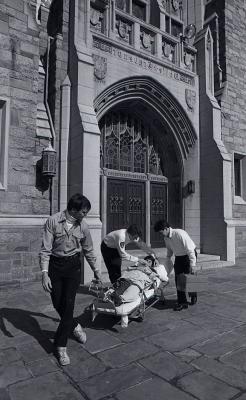The Georgetown Emergency Response Medical Service (GERMS) is a volunteer, student-run emergency medical service composed of approximately 80-100 undergraduate students who are also nationally certified EMTs. The blue uniformed members and the GERMS ambulance are a familiar campus sight, and after eventful weekends, one might hear about the unfortunate “GERMSing” of a friend who required emergency assistance. GERMS has served the University community since its inception nearly forty years ago.1
Origins
In 1982, a University student fell from the fifth floor of Healy Hall. By the time the DC Fire Department arrived nearly 25 minutes later, it was too late. The student’s death sparked a campus movement organized by Robert “Hap” Arnold, a member of the University’s Emergency Department, and Georgetown student Robert Doherty (COL ’83, MED ’87). 2That spring, Doherty submitted a proposed budget for supplies and a new ambulance to the head of the Emergency Department, and in September of 1982, GERMS received an official charter from the Student Activities Commission.3
Early history
Originally, the thirty-four GERMS members who passed the District of Columbia EMT test in December of 1982 had only a E-Z-Go electric golf cart donated by the medical school at their disposal. 4By the spring of 1983, GERMS had received its first ambulance, a converted hearse, and the Georgetown University Hospital donated equipment and medical supplies. In August of 1983, GERMS was officially dispatched for its first call, and three-person teams with beepers began responding to calls from GERMS headquarters located in the University hospital. 5By March of 1984, all on-campus calls were directed to GERMS, and GERMS began fundraising for a much needed second ambulance and insurance for its volunteers.6
Soon GERMS was providing 24 hour a day medical assistance to the University’s main campus. Members were required to complete 100 hours of classroom and practical training before spending twenty hours observing the Georgetown University Hospital Emergency Room, the DC Fire Ambulances and Medic Units, or the Washington Hospital Center’s Medstar Units. In 1990, aided by new equipment and a computerized operations system, the average GERMS response time was 3.1 minutes. 7In 1993, GERMS co-founded the National Collegiate Emergency Medical Services Organization which promotes and advocates for more than 250 campus based emergency medical service organizations.8
9/11 and Hurricane Katrina
In the aftermath of the September 11, 2001 attacks on the Pentagon, GERMS deployed an ambulance and EMTs to assist DC Fire and EMS, covered Engine 29 on MacArthur Boulevard, and sent ten EMTs to aid Georgetown University Hospital.9
When Hurricane Katrina hit in 2005, GERMS reported to the D.C. Armory’s Shelter for evacuees. For nearly two weeks, GERMS volunteers manned the First Aid Station every night from 9 p.m. until 8 a.m.10 That same year, the University gave GERMS $40,000 towards a $90,000 ambulance unit and nearly tripled the organization’s operational budget from $11,000 to $30,000. Paired with the money earned through the certification class GERMS teaches at the medical center, this funding allowed GERMS to improve the funding in its two existing ambulances and purchase a third. By the end of 2006, GERMS had received 1,142 calls, up by more than 300 from previous years.11
2008 Norovirus outbreak
In 2008, nearly 215 students became infected after a norovirus outbreak in the University’s dining hall. GERMS set up a modified command center where they treated approximately 105 students with norovirus symptoms in six days.12
University code of conduct
In 2014, the University officially added the Medical Amnesty and Good Samaritan Policy to the Code of Student Conduct. Under the policy, students seeking medical attention for themselves or a friend regarding an alcohol or drug related emergency do not face consequences for violating the Code of Conduct’s alcohol or drug related policies. While GERMS and the University had previously honored the policy, by formally recognizing the policy the University’s hoped to eliminate any hesitations patients might have about seeking emergency medical care from GERMS.13
COVID-19 pandemic
In March 2020, when the University transitioned to virtual learning during the COVID-19 pandemic, GERMS was forced to cease operations. After in-person learning returned in September 2021, GERMS resumed limited operations from 8 p.m. to 8 a.m. on Fridays and Saturdays but announced that it was unable to hire new members at that time.14 By October 2021, GERMS expanded operations to run from Thursdays at 8 p.m. through Mondays at 8 a.m.15
- 1“GERMS.” georgetownems.org.
- 2Jester, Julia. “Georgetown’s Dark Knights: GERMS’s 30 Years of Keeping the Community Safe.” The Georgetown Voice. 25 Oct. 2012.
- 3GERMS, History. georgetownems.org/history
- 4“GERMS Founder Remembered.” The Hoya. 21 Oct. 2005.
- 5Emmett Curran, Robert. “A History of Georgetown University The Rise to Prominence, 1964-89.” 2010, p. 215.
- 6Georgetown University (Washington, DC), Ye Domesday Booke, 1984, p.83.
- 7Georgetown University (Washington, DC), Ye Domesday Booke, 1990, p.23.
- 8Snyder, Haley. “GMS Celebrates New Ambulance.” The Hoya. 19 April 2016.
- 9GERMS, History.
- 10“GERMS Steps in For Red Cross.” The Hoya. 29 Sept. 2005.
- 11 DaSilva, Ellen. “Funding Hike Helps Resuscitate GERMS.” The Hoya. 30 Jan. 2007.
- 12Crovetto, Alisha. “Virus Subsides, Source Still Unknown.” The Hoya. 9 Oct. 2008.
- 13McKenna, Kelly. “Medical Amnesty Attached to Code.” The Hoya. 21 Feb. 2014.
- 14Testa, Giulia. “GERMS Slashes Operating Hours, Will Not Take New Members for Fall.” The Hoya. 10 Sept. 2021.
- 15Hardy, Liana. “GERMS Expands Operating Hours for Continuous Weekend Coverage.” The Hoya. 8 Oct. 2021.



